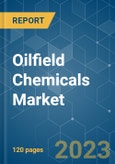Due to the impact of COVID-19, the energy demands worldwide required for mobility decreased significantly because of nationwide lockdowns and social distancing mandates. However, it is starting to rise again in line with the lifting of restrictions globally.
Key Highlights
- Growing demand for petroleum-based fuel from the transportation industry and increased shale gas exploration are expected to drive the market's demand during the forecast period.
- Clean energy initiatives are likely to hinder market growth.
- Due to deepwater drilling operations, the creation of new business horizons and production opportunities provided by developing countries are expected to act as major opportunities for the oilfield chemicals market.
- North America region is expected to dominate the market.
Oilfield Chemicals Market Trends
Drilling and Cementing Application to Dominate the Market
- In the drilling segment, oilfield chemicals are used to stabilize temperature and prevent contaminated products from entering the drilling fluid system.
- According to the International Energy Agency (IEA) and BP Statistical Review of World Energy 2022, China is one of the largest importers of crude oil, importing more than 10 million barrels a day. According to the National Bureau of Statistics, the average crude oil throughput at Chinese refineries was 14.5 million in 2021, witnessing an increase of 7.3% year-on-year hike. Additionally, according to the China National Petroleum Corporation (CNPC), the average annual increase of natural gas demand in the country is expected to exceed 20 billion cubic meters during the 14th Five-Year Plan (2021-2025) and reach 430 billion cubic meters in 2025.
- In September 2021, the Union Minister of Petroleum and Natural Gas of India stated that oil and gas projects worth USD 12 billion have been sanctioned for Northeast India and are likely to be completed by 2025. By increasing the exploration acreage in the Northeast region from 30,000 to 60,000 square kilometers, the plan is to increase oil and gas production from 9 MMTOE to 18 MMTOE by 2025.
- Oil remains the most important energy source in Japan, accounting for roughly 40% of the total energy supply, despite the fact that Japan's oil demand has been steadily declining in line with the country's overall declining total energy use. With no significant domestic production, Japan is heavily reliant on crude oil imports, with 80% to 90% coming from the Middle East.
- The oil and gas industry in Australia has played an important role in the development of the country's current economy. With the production and export of liquefied natural gas (LNG), crude oil, and condensate, Australia contributes a small but significant amount to the global oil and gas supply. The country produced 5,344 megaliters of LPG in 2021.
- According to a report published by US Census Bureau, the mining and quarrying revenue increased significantly in 2021 as compared to 2017.
- Additionally, the massive demand for technologically advanced cementing products, such as sell polyvinyl alcohol with non-ionic and low-viscous properties, is expected to create opportunities for the oilfield chemicals market.
North America to Dominate the Market
- The North American region dominates the global oilfield chemicals market due to an increased emphasis on shale gas production and exploration.
- Shale gas production has been increasing exceptionally over recent years. Due to increasing demand from the major developing economies of North America, the demand for natural gas is expected to grow over the forecast period.
- As per the Canadian Association of Petroleum Producers (CAPP), the annual revenue generated from upstream oil and natural gas in Canada fro nm 2018-2020 was USD 209 billion.
- The crude oil production in 2020 was 4.46 million barrels per day, while it increased to 4.67 million barrels per day in 2021. Production is estimated to remain at 5.85 million barrels per day in the forecast period till 2035.
- United States is one of the world's largest consumers and exporters of oil and gas. According to U.S. Energy Information Administration (EIA), Crude oil production in United States is expected to average 11.9 million barrels per day (b/d) in 2022, up 0.7 million b/d from 2021. Also, the output will exceed 12.8 million b/d in 2023, breaking the previous annual average record of 12.3 million b/d set in 2019.
- There are more than 10 large petrochemical projects under construction in the country, which have a combined value of over USD 207 billion. Thunder Horse South Expansion Phase 2 will further boost the market as it is one of the largest oil fields in the Gulf of Mexico. This project will add two new subsea production wells in the near term, and about eight wells will be drilled as part of the overall development. The other projects include Mad Dog Phase 2, Herschel, and Manuel.
- According to Energy Shale Gas Production, total natural gas production is projected to contribute 30% and more than 75% in Canada and Mexico by 2040.
- Hence, all such factors are expected to drive the growth of the oil and gas industry in North America, which is further expected to boost demand for the oilfield stimulation chemicals market.
Oilfield Chemicals Industry Overview
The oilfield chemicals market is highly consolidated. Key players in the oilfield chemicals market include Halliburton, Schlumberger Limited, Solvay, Baker Hughes Company, and Champion X.Additional Benefits:
- The market estimate (ME) sheet in Excel format
- 3 months of analyst support
This product will be delivered within 2 business days.
Table of Contents
Companies Mentioned (Partial List)
A selection of companies mentioned in this report includes, but is not limited to:
- Albemarle Corporation
- Ashland
- Baker Hughes Company
- BASF SE
- CES Energy Solutions Corp.
- Clariant
- Croda International PLC
- Chevron Phillips Chemical Company (Drilling Specialties Company)
- Dow
- Elementis PLC
- Flotek Industries Inc.
- Halliburton
- Huntsman International LLC
- Innospec Oilfield Services
- Kemira
- MPRC
- Ecolab (NALCO Champion)
- Nouryon
- Schlumberger Limited
- Solvay
- The Lubrizol Corporation
- Zirax Limited








